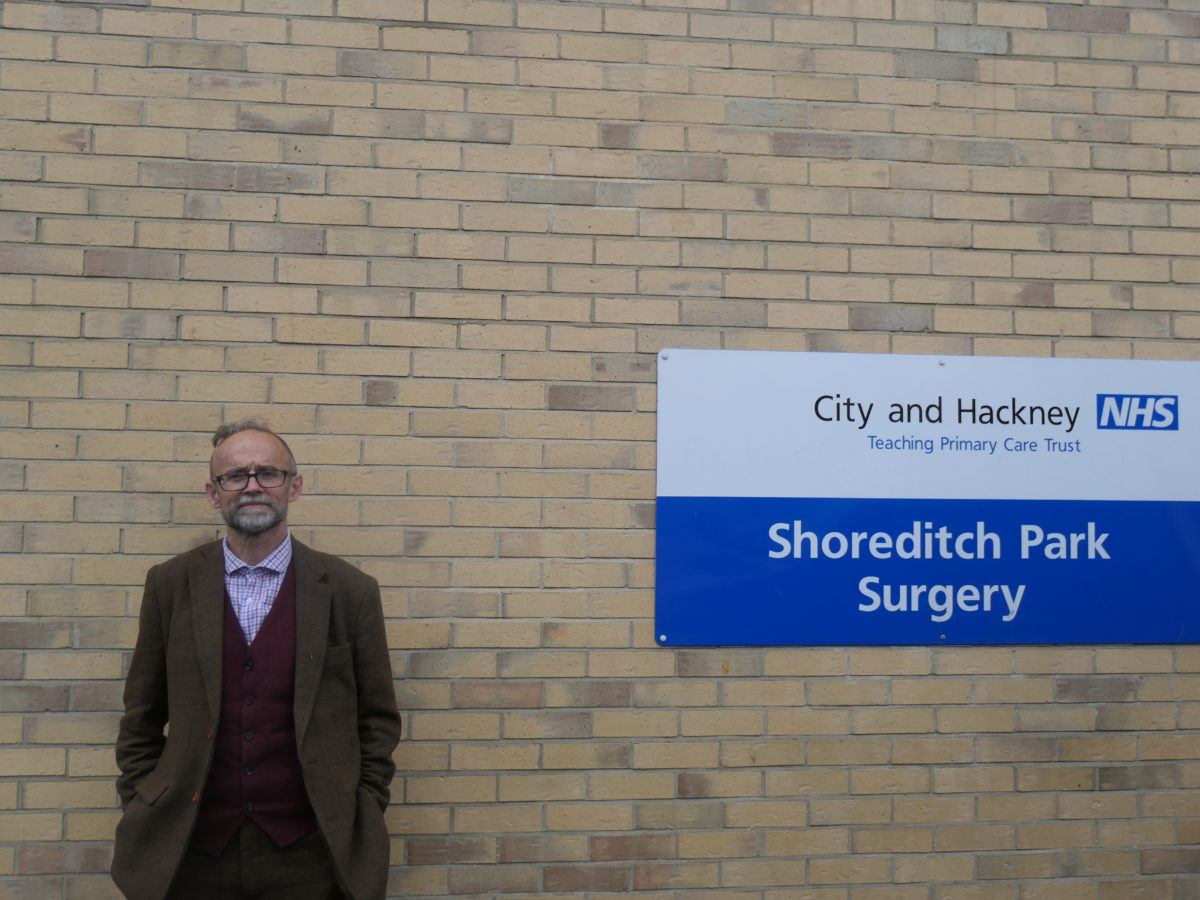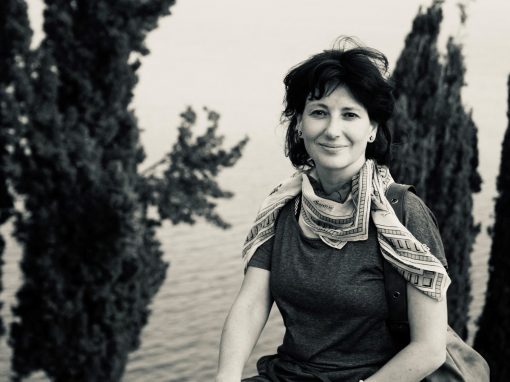Confining us to our neighbourhoods, pushing us out onto local streets and parks for some air and exercise, Covid has woken us up to the impact of the places we live on our wellbeing. It’s midweek in Hoxton, early afternoon, and I’m here with Paul Kelland to try and deepen my understanding of the links between our environment and our health. Former architect turned GP, Paul is the perfect guide, walking me around his intensely built north London patch. He’s been a GP here for twenty-five years – his life’s work he says.
Paul is slim and bearded, dapper in a tweed suit and ox-blood Doc Martens. He talks like he walks, rapidly, restlessly, impatient to get his ideas across. He swings open the door to his practice and we’re into Shoreditch Park.
Paul is alive to the shaping pull of history.
Shoreditch was once ‘sewer ditch’ and Hoxton is from ‘Hocq’s Farm’ – farm country bordered the old City wall close to Moor-gate, itself named after Moorfields, a spot of marshy land just north of the City. Somewhere nearby Ben Jonson killed the actor Gabriel Spencer in a duel but escaped hanging by demonstrating his literacy and claiming benefit of clergy. Theatrical links endure – Elizabethan theatre, Victorian music hall, the old Gainsborough Studios where Hitchcock filmed The Lady Vanishes. Even now there is a cluster of advertising studios on the edge of Paul’s patch. Although the Gainsborough has been replaced by flats, if you wander into the courtyard you’ll find a huge oxidised sculpture of Hitchcock’s head, eyes heavy-lidded, pouchy in the jowls, lugubrious.

Shoreditch Park is a little threadbare this early in Spring, a little windswept. It’s overlooked to the north by a pair of matching hexagonal brick towers by the architect David Chipperfield – one in charcoal, the other dusty terracotta – where three bed flats go for £1.5million. Beautiful, says Paul, beautiful. A 2005 dig of the park unearthed old roads and the bones of terraced Georgian houses – bombed in the Second World War then slum-cleared. We’re in the midst of what Paul calls a ‘wrap’ of housing that starts in Camden and swings around the old city wall. We pass the local pub – closed after a stabbing in the toilets – cross a road and into a triangle of grass between solid council blocks.
Municipal mown space.
Municipal mown space. Let’s call it MMS. The phrase is new to me, but I’ll never look at a city the same way. It’s the name Paul gives to the numberless fragments of grass between buildings – scuffed and yellowish fragments and offcuts. They look great on a drawing, he says, little green spaces, full of strollers, picnickers, playing children. But no. Dogs shit here and that’s about it. No benches. Ball games prohibited. Dead space, sore on the eyes. Space built to fail. Exercise is impossible, pushing people back into their homes – or gyms if they can afford it. Now he’s given a name to it, MMS is everywhere. And it’s a tell-tale, indicator of the forces at work here. The thing about MMS is its cheap to maintain. The council buzz it with a lawnmower. The planting and shaping needed to rescue these patches from dogshit take time and money. MMS clearly incenses Paul. A bête noire. It is little more than greenwashing, a pretence of environmentally friendly space, make-believe lungs for the city, utterly devoid of health benefits.
We move further into the estate, watched by a young lad in a balaclava – one of the boys, Paul calls him. Before we came out Paul showed me a drill video by local group 38 x ALZ, shot on abandoned garages near here. Sounds from the horn of Africa blend with South London rap. As theatrical as anything by Ben Jonson. But this is their patch and they defend it. White, middle-class, nosy – Paul and I stand out a mile. If he wants to be invisible on his GP visits, Paul puts on a high-viz jacket and nobody gives him a second look.
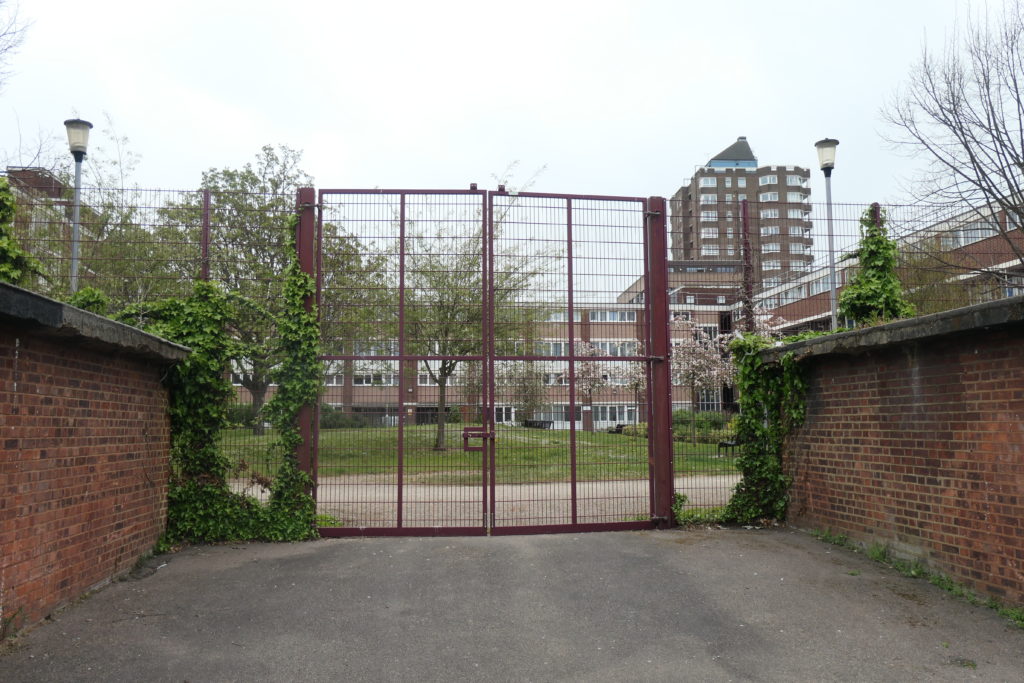
We walk between lock up garages to a courtyard garden. Security shapes the territory hereabouts. Between us and the garden is a locked 15-foot fence. Its narrow gauge makes it unclimbable – no purchase for your feet. But what makes the garden feel secure makes it feel threatened. Old steel doors are scarred by fires; anti-climb spikes balustrade the flat garage roofs; lock ups are bolted and double bolted, the relentless presence of crime visible in the defences against it.
In the 70s, architect and planner Oscar Newman responded to an urgent question: why do some neighbourhoods continue to be high crime despite the complete turnover of their populations? His answer was defensible space theory: if people have ownership of their built environments they will co-operate in its security. Look not at the population, but at the place.
Everywhere Paul points out human attempts to take a little control – to stake out a patch of garden, to gate their end of the balcony.
He compares the multi-million-pound Victorian houses of neighbouring De Beauvoir square: the graded move from main road to side road to pavement to front garden. The progressively defensible space leading to the sanctum of the home. A lot of social housing opens straight onto the street or gantry – places to hurry through to the safety of a triple-locked door. Newman’s theory is contested, but after MMS it’s the thing Paul talks about most. Combine this with the Government’s commitment to a ‘public health approach’ to violent crime, and the links between wellbeing and the built environment could hardly be stronger.
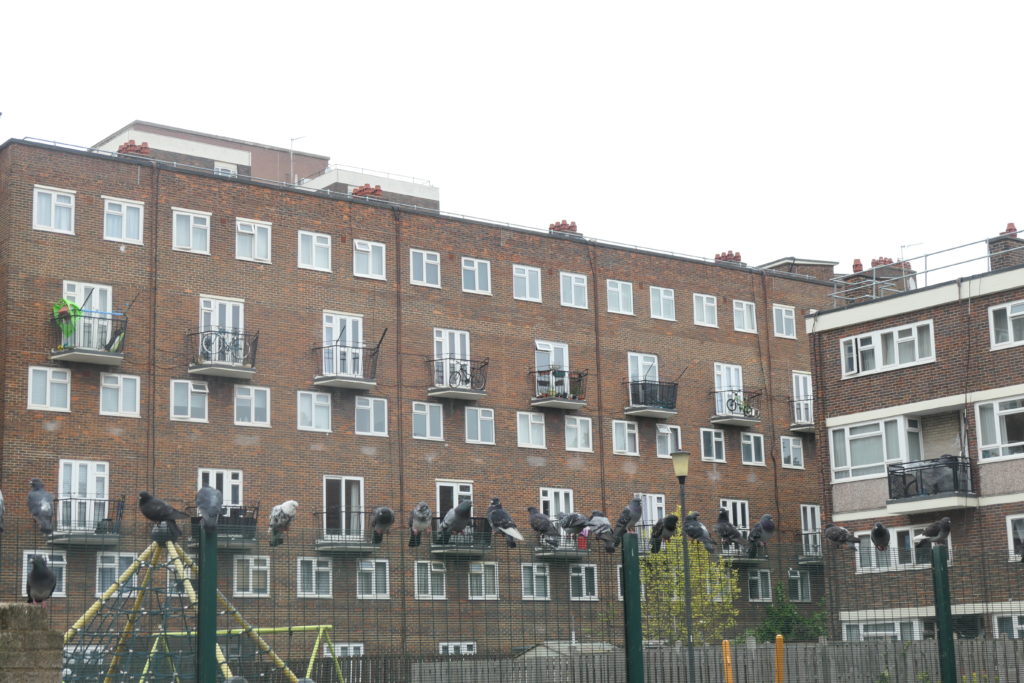
Hoxton, like much of the old East End, has been shaped by inward migration: Huguenots, Jewish émigrés, Muslims from now Bangladesh – more recently those fleeing conflict in East Africa and the greater Middle East – the Alz boys. As we turn to head north, Paul is met with an exuberant Arabic greeting – I love you Dr Paul. Bulky, eyes alive under a shock of dark hair, Paul’s patient is from a Kurdish village in northern Turkey so remote that Google Earth shows no roads. Difficult to get a mental grip on the scale of his dislocation.
De Beauvoir
We continue north to the De Beauvoir estate. Hard not to feel the pull of contradictions here, an inbreath of hope and its expiration. The estate was a 70s flagship for the London County Council, poster-child for post-slum social housing, municipal socialism and technocratic fixes for enduring social ills. Early residents, rescued from the slums – and their venal landlords – were delighted. Bathrooms, large airy flats, views over the city, manageable rents – what’s not to like? It must have felt like redemption. How things change. According to Paul, today you’d struggle to give some of them away.
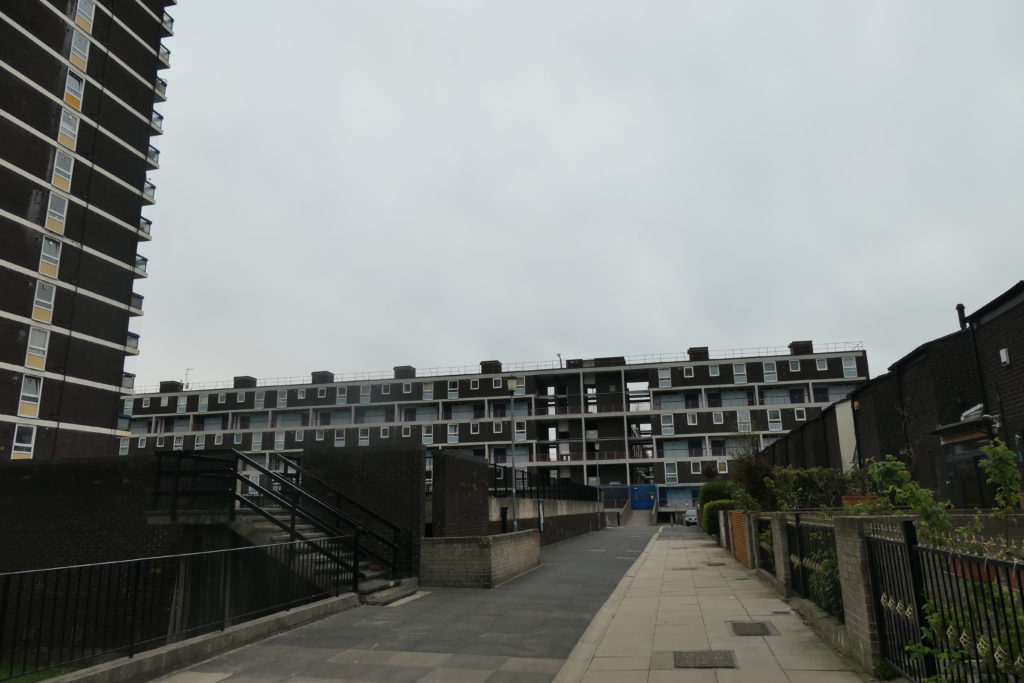
From out front, the scale remains impressive. Five ‘sentinel’ towers linked by low rise ‘snake blocks.’ Underneath are garages, long bricked up and locked down – too much violence, too many cars torched.
Entropy is much on Paul’s mind, the tendency of things to fall apart.
The white woodwork on the estate is peeling, the yellow spandrels rotting from the base. How well things are built matters. Some of the earliest social housing is impressively solid, made with an eye to the future. But without maintenance, even that decays. Work costs though. Most of the bigger blocks were designed to have concierges, someone to keep an eye out. But they’re long gone.
As we walk it becomes clear that the dilapidation of these buildings – and the exhausted spaces between – is not inevitable. It is a choice. Fail to maintain and decay settles in. Build cheap and it sets in that much more quickly. Hope is a good thing, but the vision that raised this estate has faltered. Locals prefer low rise, something on a human scale, something you can personalise. And who can blame them? But it’s unclear to me the architects are entirely at fault. Slash the maintenance budgets and even the best of buildings will slowly unravel. Concentrate the poorest and most vulnerable into dilapidating buildings and you go looking for trouble.
We look north over the snake-blocks and sentinel towers. Paul wants to bring architect students here. It may look groovy – one of Paul’s words – on a drawing, but ask yourself how you get in, how you navigate it. Try to find your way around here for an emergency call he says. Some of the lock-ups and derelict shops are nonetheless getting a makeover. There’s a chic looking architectural practice hunkered under a concrete walkover. Touches of grooviness says Paul, things changing.
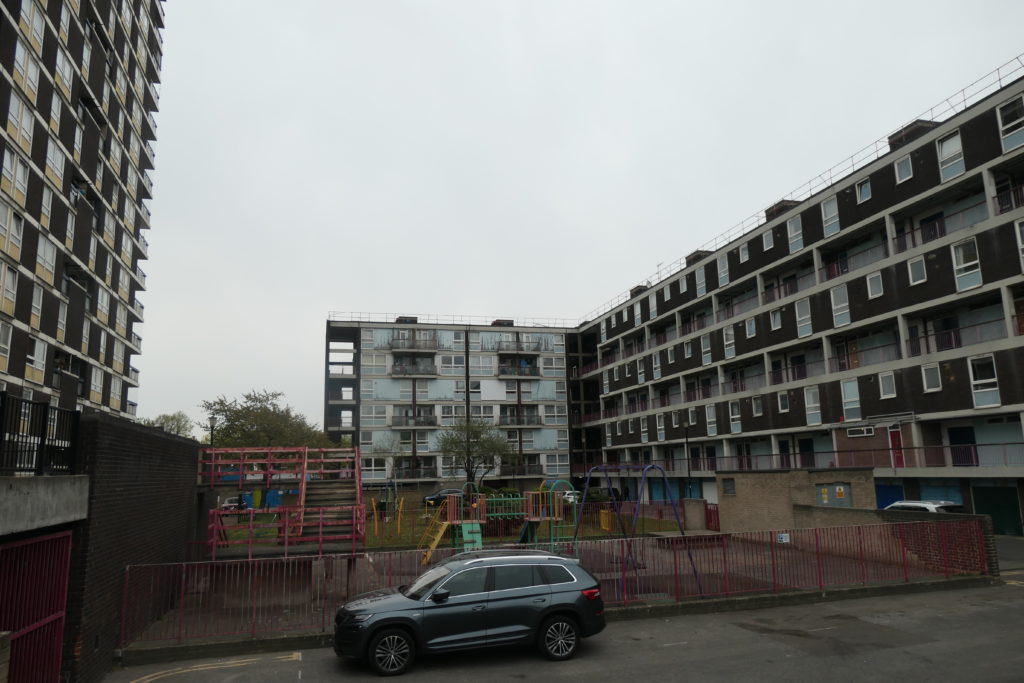
We talk for a bit about what defines a patch, a neighbourhood – what sets it apart. For the boys in 38 x Alz, it’s partly about safety and threat. Secure in their own estate, there’s a fair chance they’ll get stabbed if they wander into another fiefdom. Roads also mark out the territories – the A10 and the Great North Road here as physical a barrier as a river or mountain range. The Regent’s Canal – tow path full of joggers, waterside workshops turned cafes, coffees in the sun – another sort of boundary. There’s also postcodes. These apparently bland alphanumeric codes can harden into fate for the wrong place – a species of prophecy fulfilled by the data gatherers and the marketing agencies they sell on to.
We cross Downham Rd. London specialises in juxtaposition, but even by London standards the shift in register is abrupt.
We cut down a broad road lined with gorgeous flat-fronted houses. Unaware that I was feeling antsy, I sense my body relax, telling me I am no longer under threat. Front gardens are staked off with ironwork. Steps rise to glossed front doors. Defensible space. This is De Beauvoir Town. The trees are early-spring plush in the sunshine. I ask Paul whether the ease that overtakes me is simply my middle-classness speaking – would an Alz boy have the same response? Paul leaves me to work it out myself, but points out the visual interest, the human scale, the green stuff, the calmed traffic, the space to wander.
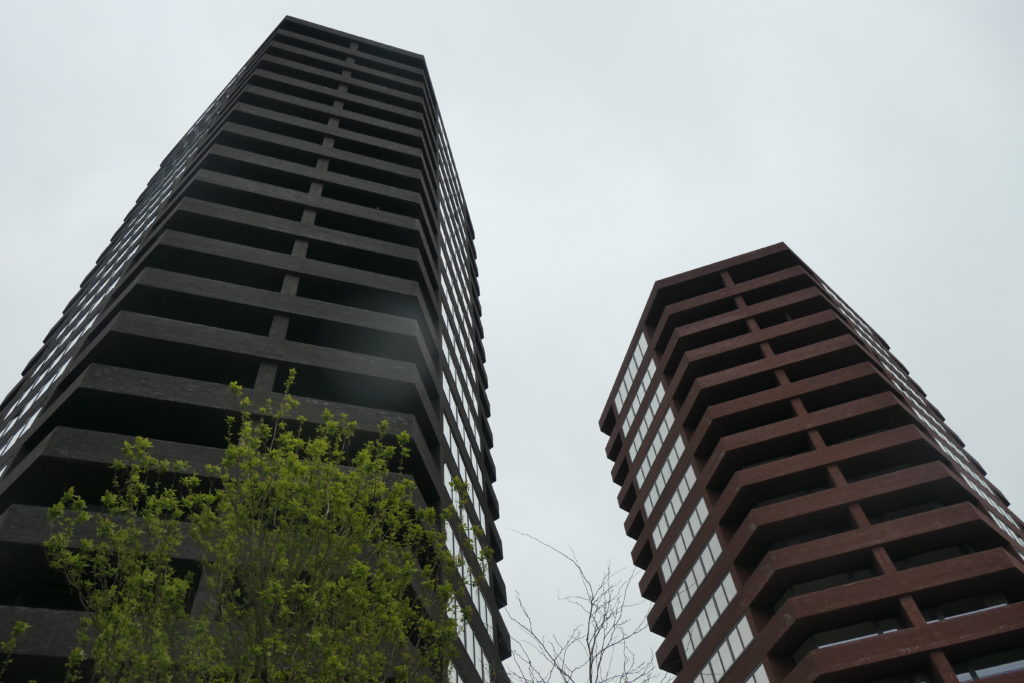
We head south again, across the canal. Paul takes me to the Chipperfield flats – Hoxton Press. I was unimpressed when I first saw them, too angular and brutal, but Paul teaches me to read them. They are superbly built from fired Belgian brick, more than a match for London entropy and almost monastic in their simplicity. Close up the colours are earthy, the bricks tactile, touch-inviting. The planning gain from these private developments is investment in local low-rise social housing and a handsome local leisure centre – the five-a-side football pitches on the roof hugely popular. It looks like a virtuous trade off.
We head back to the practice. Paul holds a powerful mental map of his patch, contoured with stories of fortitude and survival, of struggles with illness, of peaceful deaths, and deaths less peaceful. He is an extraordinary man, a great guide, committed to the wellbeing of those on his patch. He talks of the funeral of a local lad killed by addiction – all the community coming out to pay their respects. He talks of a patient dying slowly as just outside her bedroom the steel bones of a new and glitzy high rise go up in winter light. But walking this tangle of streets it’s hard not to think of what he is up against – the knowledge that illness can be built into a place, designed into it by the myopia of architects, locked further in by slashing maintenance budgets, pulling the services that support it. If we want our cities, and their inhabitants, to thrive, we must build better. And look after what we build.

